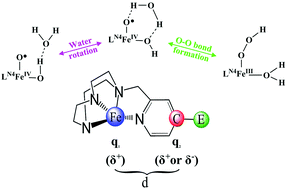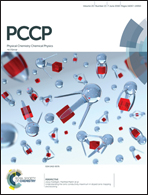Theoretical insights into the reactivity of Fe-based catalysts for water oxidation: the role of electron-withdrawing groups†
Abstract
Recent experiments have shown that complex (1), [Fe(OTf)2(Pytacn)] (OTf = CF3SO3−, Pytacn = 1-(2′-pyridylmethyl)-4,7-dimethyl-1,4,7-triazacyclononane), is a promising artificial photosynthetic catalyst because of its distinct capability in water oxidation. Experimentalists have also synthesized several derivatives, e.g., [Fe(OTf)2(E,HPytacn)] (E = –Cl (2), –CO2Et (3) and –NO2 (4)) and [Fe(OTf)2 (E,RPytacn)] (R = –F (5) and R = –Me (6)), and proposed that the E-substituted electron-withdrawing groups could improve the catalytic efficiency. However, the mechanism remains somewhat unclear, especially on the relative catalytic efficiency of these complexes. In this work, we propose an oxygen radical mechanism based on density functional theory (DFT) calculations for the six complexes. The crucial O–O bond-formation step is elucidated. Our calculations reveal that the FeIV-oxyl radical is the active species during the reaction, and the catalytic activities follow the sequence of (4) > (3) > (2) > (1) > (5) > (6), which agrees consistently with the experimental findings. Furthermore, we propose a simple charge-pair interaction model to characterize the effect of electron-withdrawing groups on the catalytic efficiency. It is clearly demonstrated that an electron-withdrawing group with a higher electronegativity is associated with a lower Gibbs free energy barrier for the O–O bond formation, which then leads to a more active catalyst. We also emphasize that the accurate description of dispersive interactions in DFT calculations is crucially important to retrieve the correct sequence of the catalytic efficiency. The theoretical insights provided in this work could be useful for the design of highly efficient Fe-based water oxidation catalysts.



 Please wait while we load your content...
Please wait while we load your content...